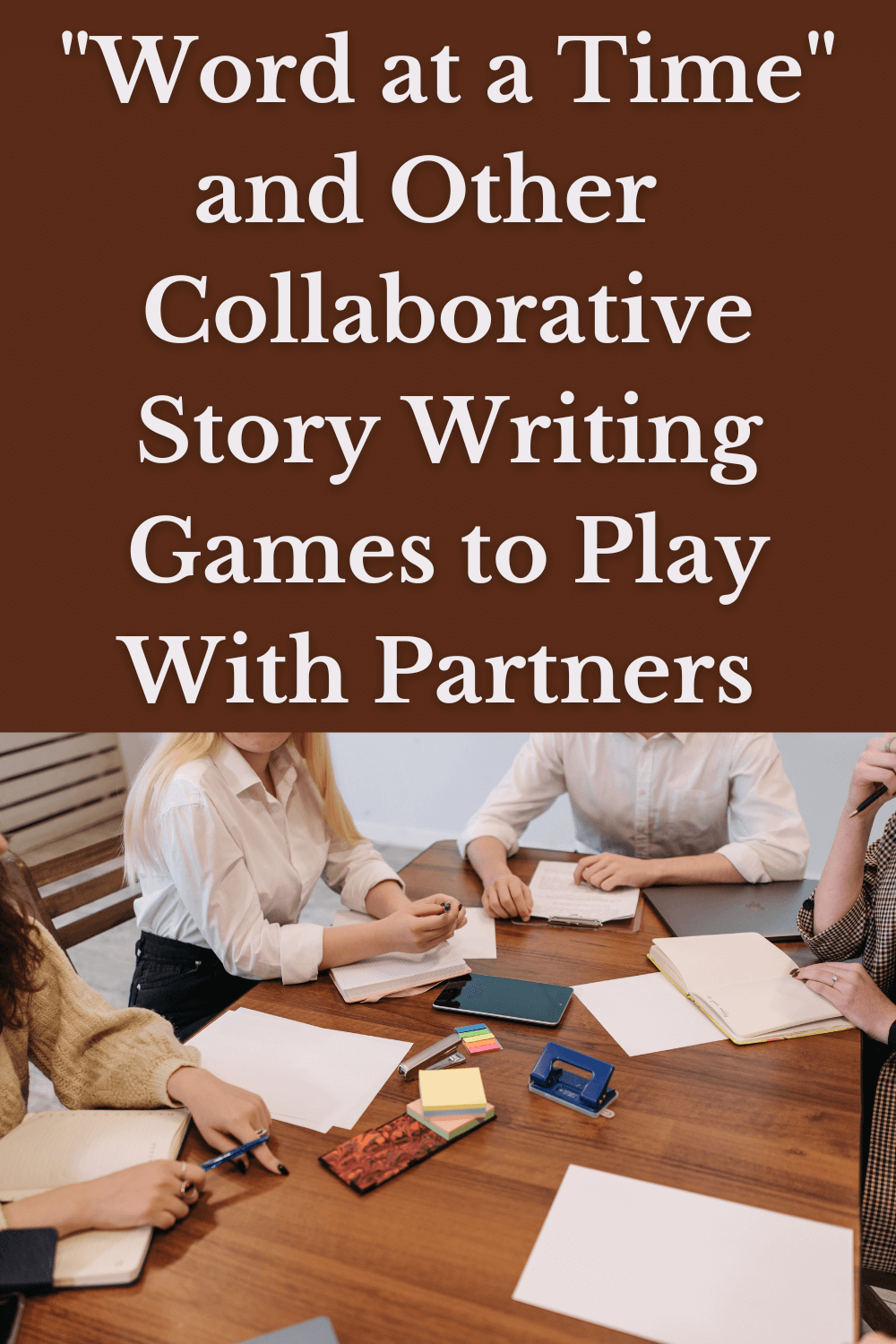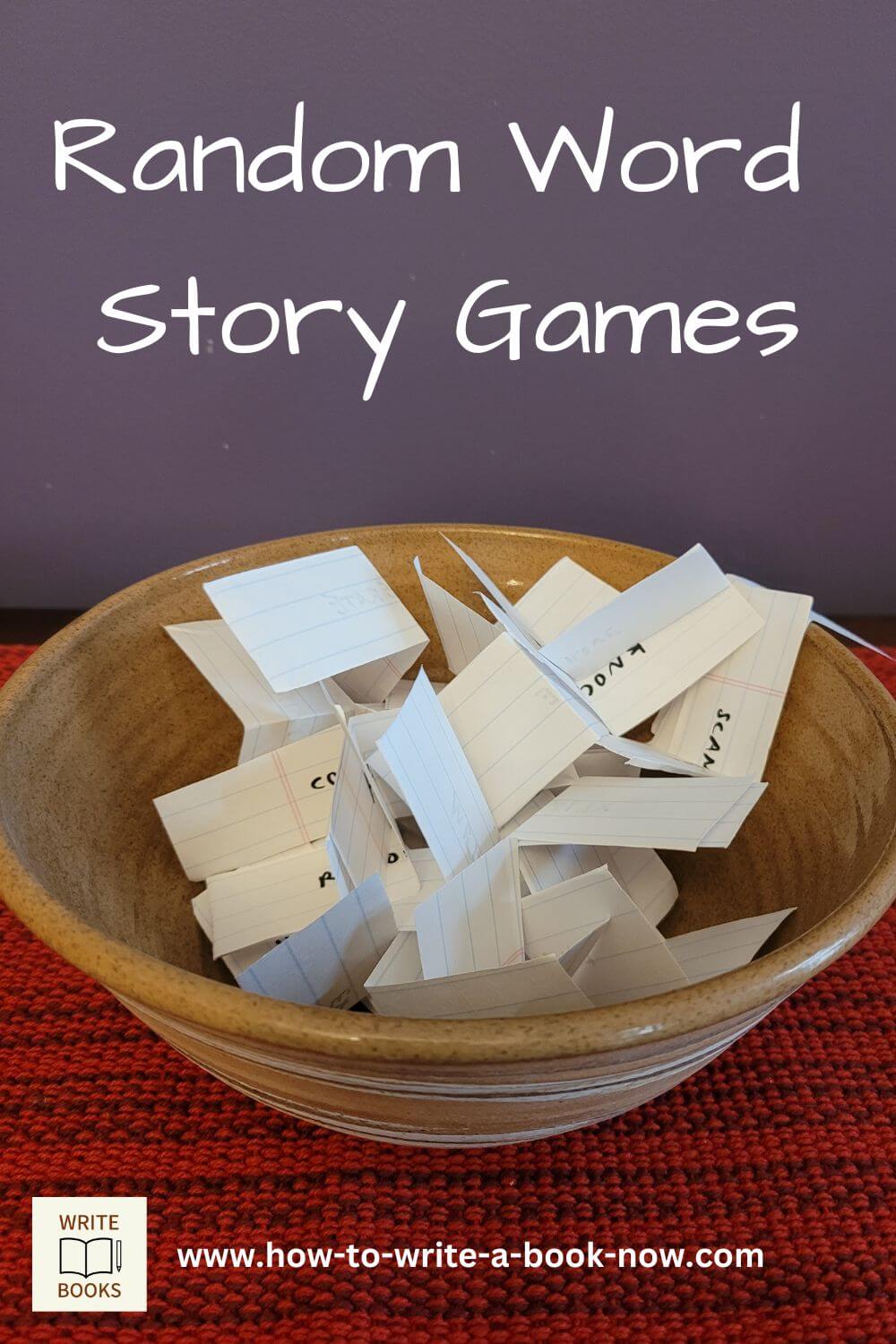The "Word-at-a-Time Story Game" and Other Collaborative Games For Writing Groups and Partners
By Glen C. Strathy
The Word-at-a-Time Story Game is a collaborative story-making game in which players take turns contributing to an emerging story. More often it is played by drama students rather than writers, as it can be a great way for actors to learn the basics of story structure while doing what they do best -- telling a story as a group endeavour.
Nonetheless, many writers also create stories in collaboration -- sometimes with a writing partner or as part of a writing team. In addition to the Word-at-a-Time Story Game, there are many similar games you and your partner or writing group can use to collaborate on creating stories. They can also be a fun element of creative writing classes or workshops. They can loosen up everyone's creative muscles, promote social interaction, expand one's understanding of storytelling, and produce original ideas. Sometimes they even lead to publishable books and stories.
Even if you only have one writer friend to collaborate with, you can use these games whenever you want a change of pace or as an alternative to brainstorming ideas.
So let's start with the easiest of these collaborative games, because it encapsulates the basic philosophy that pertains to all of them. Then I'll move on to more sophisticated versions.
The "Yes, and..." Sentence-at-a-Time Story Game
"Yes, and..." is very similar to the Word-at-a-Time Story Game, but most players find it a little easier, especially if they've never played the Word-at-a-Time Story Game.
"Yes, and..." gets its name from a core principle of improvisational theatre, which states that, when it is your turn to contribute, you must...
a) Not contradict anything that has appeared earlier in the story (i.e. say "yes" to the story so far).
b) Add something new (which is what "and..." means).
You can play this game with two players or as many as twenty. The game works with players aged 8-88, with all levels of experience. Here's how it works...
1. Participants generally sit in a circle. Whoever volunteers to go first decides whether the group will take turns going clockwise or counterclockwise around the circle.
2. The first player makes up the first sentence of a story and says it aloud.
3. The second player contributes the next sentence of the story.
4. The game continues with each player adding one sentence. Each new sentence must add something to the story without contradicting anything that came before.
5. The game ends when the story reaches a satisfactory conclusion or if everyone feels it has reached a dead end or is starting to repeat itself.
One of the key elements in the game is that no player can control the story. You have no idea what contribution the person immediately before you will make, and no way to control what the next person will do with your contribution. All you can do is accept what came before and try to give the next player something interesting to work with. (This principle is basic to all the games on this page, to prevent the arguments that can occur if one person tries to control the story.)
Another key element is that players have to listen carefully to the story, so they can make a good contribution on their turn.
Many players will feel some anxiety when it is their turn, which may cause them to experience writer's block. You may want a rule that says if a player can't think of a sentence, they can say "pass" and the turn will pass to the next player. However, in that case, the player who passed must take their turn after everyone else has gone.
In a class situation, you might play this game a number of times, encouraging the group to focus on making the best story they can. That might require debriefing after the first few rounds to ask questions like, "What were the best parts of the stories we made, and what made them good?" "What parts of the stories did you not connect with?" or "How can we make the story better next time?"
You can also play this game with a group online, using a chat app, email, or a collaborative document app, such as google docs.
The Word-at-a-Time Story Game
If your group is very comfortable with "Yes, and..." and is ready for a new challenge, you can introduce them to the Word-at-a-Time Story Game.
The
Word-at-a-Time
Story Game is exactly like "Yes, and...," except that instead of contributing one sentence, each player only contributes one word. So the first player will say the first word of a sentence, and the second player will add a second word, etc. If a player feels the sentence has reached a good stopping point, they can say "period" or "question mark" to end it. The next player will then begin a new sentence.
Pass Around Stories
As I noted above, "Yes, and..." and the Word-at-a-Time Story Game are most often played by drama students. To enjoy playing them, you have to be comfortable with having the spotlight on you for your turn.
Writers who are a little more shy might prefer to play "Pass Around Stories" instead, which requires much less talking. Here's how this game works...
Step #1: Everyone gets a blank notepad and a pen.
Step #2: Everyone writes the start of a story at the top of the page. There are different ways of setting a limit on how much everyone should write. For instance, you could have everyone write...
a) a single sentence, paragraph or at most an entire page.
b) a set number of lines, anywhere from one to ten.
b) for a set period of time, such as 10 minutes. (The advantage of this option is that everyone will be done at the same time.)
If someone is in the middle of a sentence when the limit is reached, they must leave it unfinished.
Step #3: Everyone passes their notepad to the person on their right, so that everyone receives someone else's story.
Step #4: Everyone silently reads the story they got, and then adds to the story. (Either add the same amount of text, or write for the same amount of time as the first person.) The person writing is allowed to continue the story in whatever way makes sense to them and should not consult with the person who started the story. However, the goal is to make a good, coherent story.
Step #5: Repeat this process, passing the stories around and adding to them, until everyone in the group has contributed to every story.
Step #6: Share the stories or read them aloud, so that everyone can discover what other writers did with the ideas they contributed.
You can also use this method to write stories with a single writing partner with whom you have a good working relationship. The partners take turns writing parts of a story until it reaches a good conclusion. You may decide that if, at some point, one person strongly feels they want to finish the story on their own (which often happens) they can do so. Or you may play with a rule that disallows that. It depends which approach you find is most productive and satisfying for all partners (and won't generate copyright issues if a story gets published).
There are several variations on Pass Around Stories...
The Letter Game
Sorcery & Cecilia, Or: The Enchanted Chocolate Pot
by
Patricia C. Wrede and Caroline Stevermer
A Novel Written Using The Letter Game
(As an amazon associate, this site earns from qualifying
purchases made through links to books mentioned on this page.)
In "The Letter Game," two writers attempt to write an epistolary story (that is, a story composed of letters). The rules are quite similar to the Word-at-a-Time Story Game. Here's how it works...
Step #1: The writers create two or more fictional characters. Each writer chooses the character they will write for. The writers decide on the relationship between the two characters and why they will be writing to each other.
Step #2: One writer begins by writing a letter (or email, text message, etc.) from their character to the other. The second writer then writes the second character's reply. This pattern then repeats. Each letter tells what's happening in the life of the character writing it -- one part of their story. The writers continue the process, writing their character's letters back and forth to each other until the process reaches a satisfying conclusion.
You may end up with two separate stories -- one for each character -- which is fine. Or you might find a way for the stories to merge and become one story.
For example, writers Patricia C. Wrede and Caroline Stevermer played The Letter Game, choosing for their characters two cousins in 18th century England. The result became the YA fantasy novel Sorcery and Cecilia or The Enchanted Chocolate Pot. They then went on to write two sequels, The Grand Tour and The Mislaid Magician.
Here is some advice Patricia C. Wrede once gave on playing The Letter Game:
"...remember that it is supposed to be a *GAME*, first and foremost. I've
played six letter games now, and the other five all fizzled out for one
reason or another after a few letters. They were all fun and worth
doing, though. Past that--it is useful to give the other player a few
open-ended hooks that they can pick up (or not) as they see fit... and
pay attention to the hooks the other person is throwing out for you! ...Also, you're not actually
limited to one character apiece, though if you each start playing more
than one person, it can get really hard to keep track of the chronology.
"
Round Robin Novels
An alternative to writing an epistolary novel is to have writers take turns writing chapters for a novel. Novels written in this way are sometimes called "Round Robin Novels."
One approach is to assign each writer one or more point-of-view characters. The writers then take
turns writing chapters for the novel from their
chosen character(s) perspective -- either in first person or third-person limited narration. Switching point-of-view characters in this way helps to gloss over the writers' differences in style.
However, you don't have to change point-of-view characters. You can simply have all the writers write from the same character's point-of-view and worry about stylistic differences in the editing process. If there are just two writers, they can alternate chapters. If it's a project for a big group, you can have a different writer for each chapter.
For example, in the 1930s, a group of professional British mystery writers called the Detection Club wrote a number of Round Robin Novels in which each writer wrote one chapter. Everyone was was allowed to read the chapters that came before theirs. Each writer had to come up with a solution to the mystery that fit all the preceding facts and write their chapter with that solution in mind. However, the actual solution was decided by the writer who wrote the last chapter.
Round Robin novels published by the Detection Club include The Floating Admiral by Agatha Christie et al, The Sinking Admiral by the Detection Club, and The Scoop and Behind the Screen by Agatha Christie et al.
No Rest for the Dead by Sandra Brown et al is another round robin mystery novel written by a different group of mystery writers.
A number of science fiction novels have also been written using a variation of the Round Robin Novel Game, including Black Trillium by Marion Zimmer Bradley et al, Atlanta Nights by Travis Tea (a collective name), and a variety of online or ebook novels such as The Omega Egg by Mike Resnick et al, and The Prometheus Meltdown by Victor Coman et al.
As with the Word-at-a-Time Story Game, each writer playing the Round Robin Novel Game must accept everything that came before and add something new in their chapter -- a new development in the plot or a character arc.
This is the most challenging of these games, as it takes writers with a good sense of structure to bring the story to a satisfactory crisis and resolution. However, with the right writing partners, it can be a lot of fun.
Round Robin Mystery & Science Fiction Novels
(As an amazon associate, this site earns from qualifying purchases made through links to books mentioned on this page.)
- Home
- Writing Games
- Collaborative Games
























